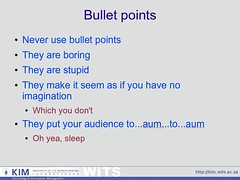It is common practice for meeting facilitators to record discussion on a flip chart as bullet points. This does not work for many knowledge management meetings.
Bullet points are short phrases or keywords recorded as a list, rather like the example to the right. They are not sentences, they do not explain, they contain little or no context, and are succinct summaries.We record bullet points in meetings as a reminder of what we have discussed, and as a way of keeping track of the progress of the meeting. The lack of context is not a problem, because everyone at the meeting was part of the discussion, and knows the context. Therefore the bullet points act like signposts or markers which remind participants of key points within a shared context.
When it comes to transferring knowledge to people who were not present, who did not take part in the discussion, and who do not have the shared context, bullet points usually do not work. You cannot be "reminded" by a bullet point, if you were not part of the conversation, and providing someone with a list of bullet points ane expecting them to derive knowledge from them is futile.
Therefore in knowledge transfer exercises where there is also a wish to capture the knowledge for others, or for future use, bullet points alone do not work.
In Retrospect (lesson learned) meetings, learning histories, or when capturing knowledge from individuals, you need a full transcript of what was said, in order to document the knowledge in full, with the necessary context. You have to be able to speed type, or you have to record the meeting for later transcription.
On the other hand, in a meeting where knowledge transfer through discussion is the sole aim, with no need to record the knowledge for others, then bullet points are sufficient. In an After Action review or a Peer Assist, where the users of the knowledge took an active part in the discussion, and the knowledge will be used immediately, then it may well be OK to record bullet points, and to rely on the participants' memories and personal notes of the conversation to fill in the gaps.





2 comments:
Good point! I use an approach that is somewhere in the middle of the spectrum between no notes at all and a full transcript which also allows for non-attribution. When I facilitate, I also take some notes on a flip chart. The purpose of the flip chart is twofold: 1) keep some high level record of key points; 2) keep the conversation moving (if a point has already been made, it's visible). In most cases, an unbiased notetaker is also taking much more detailed notes. I want as much as possible of what was said but I don't care who said it. Then comes the fun part of transforming the conversation into a "conversation map." A conversation map is an adaptation of a concept map. The main difference is that I don't work with concepts as the primary element, I work with key ideas as the primary element to document. The mapping involves both documenting the key elements of the conversation AND highlighting key insights that are particularly relevant for knowledge transfer. The resulting map is then validated by the team that generated the source conversation. Reading a conversation map is much less boring than reading the full transcript of a conversation and provides much more context than a bullet point list of key insights. It's not perfect but it's a nice compromise between bullet points and full transcript.
Nick, great column. Reflexively many facilitators will tend to use bullet points, so this is worthwhile cautionary advice.
Barbara, is there any useful guidance, or good online examples, available for conversation maps?
Post a Comment